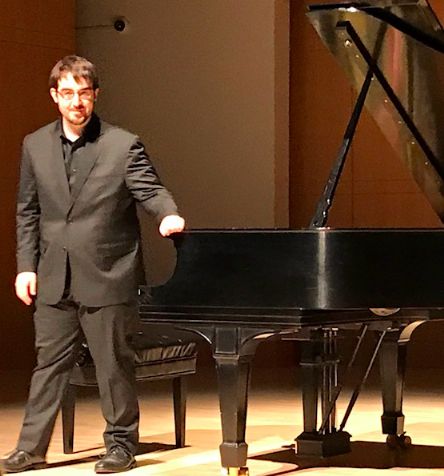|
Symphony
FROM THE NEW WORLD TO THE OLD WORLD
by Peter Lert
Saturday, June 14, 2025
Chamber
MC2 DUO RECITAL CLOSES 222'S SEASON
by Terry McNeill
Saturday, June 14, 2025
Choral and Vocal
CANTIAMO SONOMA'S LUSCIOUS A CAPELLA SINGING IN SEASON ENDING CONCERT
by Pamela Hicks Gailey
Sunday, June 8, 2025
Symphony
SRS SEASON ENDS WITH RESOUNDING TA-TA-TA-BANG
by Terry McNeill
Sunday, June 1, 2025
Symphony
YOUTHFUL VIRTUOSITY ON DISPLAY AT USO'S MAY CONCERTS
by Peter Lert
Saturday, May 17, 2025
Symphony
MYSTICAL PLANETS AND LIVELY GERSHWIN ORTIZ AT FINAL SRS CONCERT
by Peter Lert
Sunday, May 4, 2025
Symphony
VSO'S CONCERT MUSIC OF TIME, MUSIC OF PLACE
by Peter Lert
Sunday, April 27, 2025
VOCAL ELEGANCE AND FIRE AT THE 222'S RECITAL APRIL 26
by Pamela Hicks Gailey
Saturday, April 26, 2025
CANTIAMO SONOMA SINGS AN INSPIRED GOOD FRIDAY MOZART REQUIEM CONCERT
by Pamela Hicks Gailey
Friday, April 18, 2025
DRAMATIC SHOSTAKOVICH SYMPHONY CLOSES PHILHARMONIC'S 25TH SEASON
by Terry McNeill
Sunday, April 13, 2025
|
 |
 Charles Richard-Hamelin in Schroeder March 25 (JCM Photo) |
HAMELIN'S HUSKY MOOD IN SCHROEDER RECITAL
by Terry McNeill
Sunday, March 25, 2018
Convention in piano recitals has the artist coming on stage and playing. Canadian pianist Charles Richard-Hamelin walked on Schroeder Hallís stage March 25 and didnít play for six minutes, chatting with the audience. A risk for some artists. Then most programs include a contemporary or rarely played work (Ligeti, Anton Rubinstein, Alkan, Field). Mr. Hamelin programmed just conventional Schumann and Chopin. Another risk, and with easy comparisons with more established pianists than the 29-year old competition winner.
What was not risky was Mr. Hamelinís musical approach, as he was unconventional in a boisterous and dramatic mood during almost all of the Schumann Op. 18 Arabesque and C Major Fantasia, and the Four Chopin Ballades. He played the C Major Arabesque with the cantabile the 1839 work needs, and used the shift pedal often to color the sound and the two contrasting episodes.
In the famous Fantasia the long first movement unfolded in dramatic fashion, and Mr. Hamelin made it harmonically clear that the key never really resolves into C Major until the last page. Oddly he played three final soft chords where the score indicates only two. An occasional bass doubling again pointed to the workís complex harmonic structure. It was a powerful reading but never willful. In the marvelous March movement Mr. Hamelinís pianism was convincing in its energy but less so in tonal beauty. But itís that kind of movement, and he three times doubled left-hand chords for potent interest, the last before the legendary contrary-motion skips in both hands (which he nailed without apparent fear).
Lovely modulations were highlighted in the dreamy finale, played more rapidly than conventionally, and the small climaxes were carefully shaped. The second chorale theme had beauty, with balanced chords before the last long section began. The three pianissimo chords that end the piece were masterfully even and at soft volume heard to the back of the Hall.
Following intermission Mr. Hamelin again spoke at length to the audience of 150, sometimes indistinctly though using a microphone, and began with the ever-popular Chopin G Minor Ballade, Op. 23. There was a natural rise and fall to the phrasing and general sonic muscle, though the right hand octaves in the repetition of the second theme were played too fast for clarity. This Ballade has a narrative backbone that Mr. Hamelin set out well. Big boned playing continued in the F Major Ballade, a piece where cascades of sonorities were effectively delivered, and the carnage of the final measures led into a quiet and simple ending. Momentum from the previous two Ballades carried over to the A Flat, the most congenial of the four, and was a little out of place. Mr. Hamelin used a lot of damper pedal and pushed the tempo. He is not a colorist and here energy tempted lyricism.
The recital ended with the F Minor Ballade, with the Schumann Fantasia one of the peaks of 19th-Century piano literature, and when played by a seasoned virtuoso it is a cosmos of emotions in fewer than ten minutes. Mr. Hamelinís conception this afternoon was conventional but never routine, and there was abundant power and voice leading. The tenor section was taken slowly. Before the tumultuous coda the pianist avoided extending the bottom C Major Chord with pedal (the Slavic tradition) prior to the five soft anticipatory chords, and signaled the rushed drive to the finish with impressive fury and clarion speed. On balance it was the best local set of Chopin Ballades since Lang Langís Weill Hall 2013 opening concert, and the more recent Nancy Lee Harper traversal for Concerts Grand.
One encore was offered, a transcription (Wilhelm Kempff?) from Bachís keyboard Concerto in F. It was sensuously played, and a warm change from tempestuous pianistic brilliance of the glorious Ballades.
|

